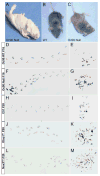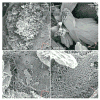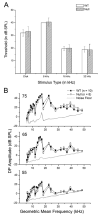Otoconin-90 deletion leads to imbalance but normal hearing: a comparison with other otoconia mutants
- PMID: 18355969
- PMCID: PMC2567131
- DOI: 10.1016/j.neuroscience.2008.01.055
Otoconin-90 deletion leads to imbalance but normal hearing: a comparison with other otoconia mutants
Abstract
Our sense of gravitation and linear acceleration is mediated by stimulation of vestibular hair cells through displacement of otoconia in the utricle and saccule (the gravity receptor organ). We recently showed that otoconin-90 (Oc90) deletion led to formation of giant otoconia. In the present study, we determined the extent to which the giant otoconia affected balance and gravity receptor sensory input and compared the findings with other otoconia mutants. We employed a wide spectrum of balance behavioral tests, including reaching and air-righting reflexes, gait, swimming, beam-crossing, rotorod latencies, and a direct measure of gravity receptor input, vestibular evoked potentials (VsEPs). All tests on homozygous adult mutants consistently ranked the order of imbalance as (from worst to best) Nox3(het)<otopetrin 1(tlt)<Oc90 null<Oc90 wild type and C57Bl/6 mice using systematic statistical comparisons of the frequency of occurrence or the severity of abnormal functions. This order coincides with the degree of otoconia deficiencies and is consistent with VsEP measures. Notably, all mice (except Nox3(het)) showed remarkable learned adaptation to peripheral vestibular deficits by staying on the rotating rod significantly longer in each successive trial, and the rate and extent of such learned improvements ranked the same order as their initial balance ability. Despite the vestibular morbidity, Oc90 null mice had normal hearing, as measured by auditory brainstem responses (ABRs) and distortion products of otoacoustic emissions (DPOAEs). The study demonstrates that the remnant otoconia mass in Oc90 nulls does stimulate the gravity receptor organs, which was likely responsible for the improved balance performance relative to strains with absent otoconia. Furthermore, the combination of direct electrophysiological measures and a series of behavioral tests can be used to interpret the imbalance severity arising from altered inputs from the gravity receptor end organ.
Figures






Similar articles
-
Gene targeting reveals the role of Oc90 as the essential organizer of the otoconial organic matrix.Dev Biol. 2007 Apr 15;304(2):508-24. doi: 10.1016/j.ydbio.2007.01.013. Epub 2007 Jan 12. Dev Biol. 2007. PMID: 17300776 Free PMC article.
-
Prescription of Controlled Substances: Benefits and Risks.2025 Jul 6. In: StatPearls [Internet]. Treasure Island (FL): StatPearls Publishing; 2025 Jan–. 2025 Jul 6. In: StatPearls [Internet]. Treasure Island (FL): StatPearls Publishing; 2025 Jan–. PMID: 30726003 Free Books & Documents.
-
Osteopontin is not critical for otoconia formation or balance function.J Assoc Res Otolaryngol. 2008 Jun;9(2):191-201. doi: 10.1007/s10162-008-0117-z. Epub 2008 May 6. J Assoc Res Otolaryngol. 2008. PMID: 18459000 Free PMC article.
-
Falls prevention interventions for community-dwelling older adults: systematic review and meta-analysis of benefits, harms, and patient values and preferences.Syst Rev. 2024 Nov 26;13(1):289. doi: 10.1186/s13643-024-02681-3. Syst Rev. 2024. PMID: 39593159 Free PMC article.
-
Assembly of the otoconia complex to the macular sensory epithelium of the vestibule.Brain Res. 2006 May 26;1091(1):47-57. doi: 10.1016/j.brainres.2006.02.083. Epub 2006 Apr 4. Brain Res. 2006. PMID: 16600187 Review.
Cited by
-
cVEMP correlated with imbalance in a mouse model of vestibular disorder.Environ Health Prev Med. 2019 Jun 1;24(1):39. doi: 10.1186/s12199-019-0794-8. Environ Health Prev Med. 2019. PMID: 31153359 Free PMC article.
-
Congenital vestibular disease in captive Sumatran tigers (Panthera tigris ssp. sumatrae) in Australasia.Vet J. 2015 Nov;206(2):178-82. doi: 10.1016/j.tvjl.2015.09.005. Epub 2015 Sep 9. Vet J. 2015. PMID: 26403953 Free PMC article.
-
Genome-wide association study identifies nox3 as a critical gene for susceptibility to noise-induced hearing loss.PLoS Genet. 2015 Apr 16;11(4):e1005094. doi: 10.1371/journal.pgen.1005094. eCollection 2015 Apr. PLoS Genet. 2015. PMID: 25880434 Free PMC article.
-
Mammalian Otolin: a multimeric glycoprotein specific to the inner ear that interacts with otoconial matrix protein Otoconin-90 and Cerebellin-1.PLoS One. 2010 Sep 15;5(9):e12765. doi: 10.1371/journal.pone.0012765. PLoS One. 2010. PMID: 20856818 Free PMC article.
-
Preserved otolith organ function in caspase-3-deficient mice with impaired horizontal semicircular canal function.Exp Brain Res. 2015 Jun;233(6):1825-35. doi: 10.1007/s00221-015-4254-4. Epub 2015 Apr 1. Exp Brain Res. 2015. PMID: 25827332 Free PMC article.
References
-
- Andreescu CE, De Ruiter MM, De Zeeuw CI, De Jeu MT. Otolith deprivation induces optokinetic compensation. J Neurophysiol. 2005;94:3487–3496. - PubMed
-
- Anniko M. Development of the vestibular system. In: Coleman JR, editor. Development of sensory systems in mammals. New York: John Wiley & Sons; 1990. pp. 341–400.
-
- Anniko M, Wenngren BI, Wroblewski R. Aberrant elemental composition of otoconia in the dancer mouse mutant with a semidominant gene causing a morphogenetic type of inner ear defect. Acta Otolaryngol. 1988;106:208–212. - PubMed
-
- Banfi B, Malgrange B, Knisz J, Steger K, Dubois-Dauphin M, Krause KH. NOX3, a superoxide-generating NADPH oxidase of the inner ear. J Biol Chem. 2004;279:46065–46072. - PubMed
-
- Besson V, Nalesso V, Herpin A, Bizot JC, Messaddeq N, Romand R, Puech A, Blanquet V, Herault Y. Training and aging modulate the loss-of-balance phenotype observed in a new ENU-induced allele of Otopetrin1. Biol Cell. 2005;97:787–798. - PubMed
Publication types
MeSH terms
Substances
Grants and funding
LinkOut - more resources
Full Text Sources
Molecular Biology Databases

